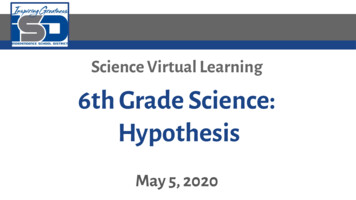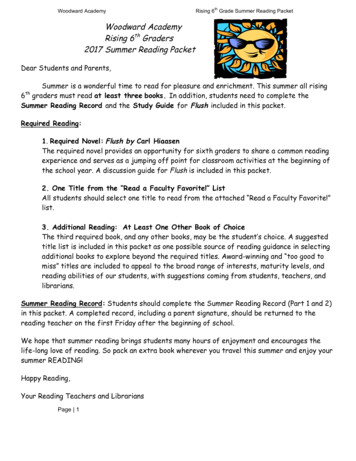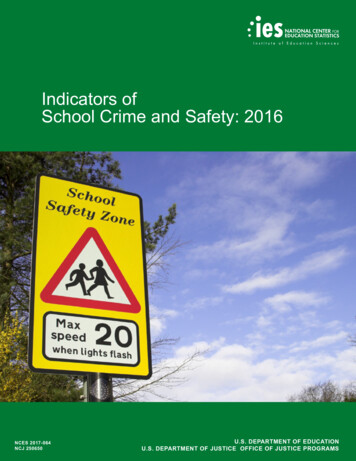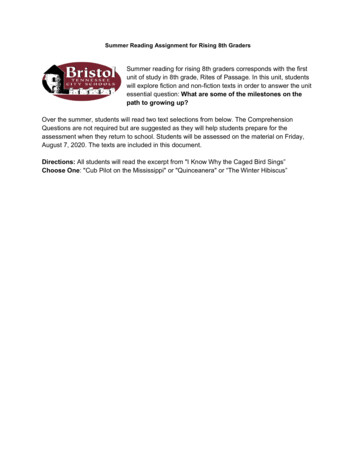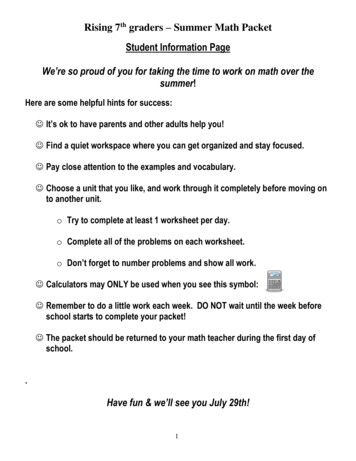
Transcription
Rising 7th graders – Summer Math PacketStudent Information PageWe’re so proud of you for taking the time to work on math over thesummer!Here are some helpful hints for success: It’s ok to have parents and other adults help you! Find a quiet workspace where you can get organized and stay focused. Pay close attention to the examples and vocabulary. Choose a unit that you like, and work through it completely before moving onto another unit.o Try to complete at least 1 worksheet per day.o Complete all of the problems on each worksheet.o Don’t forget to number problems and show all work. Calculators may ONLY be used when you see this symbol: Remember to do a little work each week. DO NOT wait until the week beforeschool starts to complete your packet! The packet should be returned to your math teacher during the first day ofschool.Have fun & we’ll see you July 29th!1
Rising 7th graders – Summer Math PacketUnit: KNOWLEDGE of ALGEBRA, PATTERNS, and FUNCTIONSObjective: Write an algebraic expression to represent unknown quantities. A variable is a symbol, usually a letter, used to represent a number. Algebraic expressions are combinations of variables, numbers, and at least one operation.Examples:The sum of 5 and some number is written as:addition.5 nbecause the operation that is associated with the word sum isThe difference of a number and three tenths is written as:word difference is subtraction.n - .31.)because the operation that is associated with the2.)a number plusa number minus .7123.)4.)the difference of twenty-one hundredths and a numberthe sum of a number and forty-six5.)6.)Robert has sixty-five more football cardsthan his friend, John.Janell is five-eighths of an inch shorter than Shakiya.2
Rising 7th graders – Summer Math PacketUnit: KNOWLEDGE of ALGEBRA, PATTERNS, and FUNCTIONSObjective: Evaluate an algebraic expression. A variable is a symbol, usually a letter, used to represent a number. Algebraic expressions are combinations of variables, numbers, and at least one operation. Multiplication in algebra can be shown as 4n or 4 x n The variables in an algebraic expression can be replaced with any number. Once the variables have been replaced, you can evaluate, or find the value of, the algebraic expression.Examples:Evaluate 44 nif n 944 n44 953original expressionreplace the variable with it’s valuesolution7.)8.)Evaluate 150 nif n 15Evaluate 12n9.)if n 910.)Evaluate 15n 19if n Evaluate 30n1311.)if n 2.512.)Evaluate 24n kEvaluate nk – 2b 8if n 6 and k 83if b 1.5, k 8, and n 7
Rising 7th graders – Summer Math PacketUnit: KNOWLEDGE of ALGEBRA, PATTERNS, and FUNCTIONSObjective: Evaluate numeric expressions using order of operations. A numerical expression is a combination of numbers and operations. The Order of Operations tells you which operation to perform first so that everyone gets the same final answer. The Order of Operations is: Parentheses, Exponents, Multiplication or Division (left to right), and Addition orSubtraction (left to right.)Examples:48 (3 3) – 2248 6 - 2248 6 – 48–44original expressionsimplify the expression inside the parenthesescalculate 22divide 48 by 6subtract 4 from 813.)14.)(8 1) x 12 – 1313 x 4 – 72 815.)16.)88 – 16 x 5 2 – 3100 52 x 4317.)18.)45 9 – 3 2 x 3(52 33) x (81 9) 104
Rising 7th graders – Summer Math PacketUnit: KNOWLEDGE of ALGEBRA, PATTERNS, and FUNCTIONSObjective: Determine the unknown in a linear equation (addition & subtraction). Addition equations: Subtract the same number from each side of the equation so that the two sides remain equal. Subtraction equations: Add the same number to each side of the equation so that the two sides remain equal.Examples:b 3 6-3 -3b 0 3b 3original equationsubtract 3 from each sidesolutionsimplifyb–8 4 8 8b 0 12b 1219.)original equationadd 4 to each sidesolutionsimplify20.)g 5 12s – 12 2921.)22.)m 3.5 10.5k – 5.5 8.523.)24.)w 6.25 22g – 3.75 49.755
Rising 7th graders – Summer Math PacketUnit: KNOWLEDGE of ALGEBRA, PATTERNS, and FUNCTIONSObjective: Determine the unknown in a linear equation (multiplication & division). In a multiplication equation, the number by which a variable is multiplied is called the coefficient. In the multiplicationequation 2x 8, the coefficient is 2. Multiplication equations: Divide both sides by the coefficient so that the two sides remain equal.x In a division equation, the number by which the variable is divided is called the divisor. In the division equation ,44 is the divisor. Division equations: Multiply both sides of the equation by the divisor so that the two sides remain equal.Examples:4b 16original equation4divide both sides by 441b 4b 4m6m6x61mmsolutionsimplify25.) 11original equation 11 x 6multiply each side by 6 66 66solutionsimplify26.)k 897x 6327.)28.)n 5.5575b 3.5529.)30.)p 2.671312m 84.726
Rising 7th graders – Summer Math PacketUnit: KNOWLEDGE of GEOMETRYObjective: Identify and describe diagonal line segments.Textbook Section: NONE A line segment connecting two vertices of a polygon is either a side or a diagonal.BExamples:ACEAE is a side of polygon ABCDEAD is a diagonal of polygon ABCDED31.)32.)Circle all of the diagonals of polygon ABCDEF.Is AB a diagonal of polygon BDCDDCECFCAE AFBE BFCE CFDE DFED EFFD FE34.)Name one diagonal of polygon WXYZDName all of the diagonals polygon ABCDEBAACCBE35.)D36.)Draw one diagonal on polygon KLMNADraw all of the diagonals of polygon ABCDEFGHCBDBCADHEG7F
Rising 7th graders – Summer Math PacketUnit: KNOWLEDGE of GEOMETRYObjective: Compare or classify triangles as scalene, equilateral, or isosceles.Triangles are polygons that have three sides, three vertices, and three angles.Triangles can be classified by the number of congruent sides, which are sides of equal length.The same markings on the sides of a triangle show that the sides are congruent.Examples:Equilateral triangleThree congruent sidesIsosceles triangleTwo congruent37.) Shown is Equilateral triangle ABC.38.) Shown is Isosceles triangle XYZ.AAB 6 cm.YXY 5 in.What must be the lengthof side YZ ?XBC CA CB39.) Shown is Scalene triangle MNO.Circle the set of numbers whichcould be the lengths of thethree sides.3 cm, 5 cm, 6 cm2 cm, 4 cm, 4 cm2 cm, 2 cm, 2 cmScalene triangleNo congruent sidesZ40.) Classify triangle DEF.FMEquilateralNScaleneEIsoscelesDO41.) Draw an Equilateral triangle. Label the vertices.Name the sides and their lengths.42.) Draw a Scalene triangle. Label the vertices. Namethe sides and their lengths.8
Rising 7th graders – Summer Math PacketUnit: KNOWLEDGE of GEOMETRYTextbook Section: 13-4bObjective: Compare or classify triangles as equiangular, obtuse, acute, or right.Triangles are polygons that have three sides, three vertices, and three angles.Triangles can be classified according to their angles.All triangles have at least 2 acute angles. Acute, Right, and Obtuse triangles are classified according to theirthird angle.The same markings on the angles of a triangle show that the angles are congruent.Examples:Equiangular triangleThree congruent angles43.)Acute triangleThree acute anglesRight triangleOne right angleWhat type of triangle is this?44.)Obtuse triangleOne obtuse angleWhat type of triangle is this?Circle the correct answer:Circle the correct RightObtuse45.) What type of triangle is this?46.) What type of triangle is this?Circle the correct answer:Circle the correct RightObtuse47.) Melissa needs to draw some triangles as part of herGeometry homework. She confuses acute and obtusetriangles. Which triangle should have one angle that isgreater than 90º? Why?48.) Jack and his dad are building a triangular pen forJack’s new puppy, a Jack Russell Terrier. Jack’s dadwants to make the project as easy as possible. Which typeof triangle should they use as a model? Why?9
Rising 7th graders – Summer Math PacketUnit: KNOWLEDGE of GEOMETRYTextbook Section: NONEObjective: Use the concept of the sum of angles in any triangle is 180º to determine the third anglemeasure of a triangle given two angle measures without a diagram.Triangles are polygons that have three sides, three vertices, and three angles.The sum of the measures of the angles of a triangle is 180 .AExamples:BCAngle A 65 Angle B 60 Angle C ?180 – 65 – 60 5549.) Given triangle XYZ:Angle C 55 50.) Given triangle MNO:Angle X 90 Angle M 15 Angle Y 45 Angle N Angle Z Angle O 135 51.) Given right triangle ABC:52.) Given equiangular triangle FGH:Angle A is the right angleWhat is the measure of Angle B 55 Angle F? Angle C Angle G? Angle H? 53.) Given triangle JKL:54.) Teri is making a scrapbook page of her trip to the artexhibit, “Geometry in Your World.” She wants to use alarge triangle as her background focus. She draws atriangle with the first two angle measures of 100 and 25 .Angle J 120 Angle K 50 Angle L 20 What is the angle measure of the third angle? Is this possible? Explain why or why not using math.Please show your work:10
Rising 7th graders – Summer Math PacketUnit: KNOWLEDGE of GEOMETRYObjective: Identify and describe the parts of a circle (circumference, radius, or diameter).A circle is a set of points equidistant from a given point.The radius is a line segment that has one endpoint at the center and the other endpoint on the circle.The diameter is a line segment that passes through the center of the circle and has both endpoints on the circle.The circumference of a circle is the distance around the circle.Examples:RS SR is a radius of the circle. ST is also a radius of the circle.RT is the diameter of the circle.TThe circumference of the circle is the distance around the circle frompoint R to point R.55.)56.)Name a radius:Name the diameter:Label radius WV.AC Label radius WX.BTo measure the circumferenceof the circle, you could start atpoint or point . Name the diameter:57.) Draw a circle.Draw a center point and label it H.Draw the diameter FG .58.)YName all of the radii:Name the two radii: andAC Name all of the diameters:59.) Draw and label a diameter in each circle.Draw and label 2 radii in each circle.Z60.) Draw and label a diameter in each circle.Draw and label 2 radii in each circle.11B
Rising 7th graders – Summer Math PacketUnit: KNOWLEDGE of GEOMETRYTextbook Section: 4-6Objective: Identify and compare the relationship between the parts of a circle using radius, diameter,and circumference (pi 3.14).The radius of a circle is ½ the length of the diameter. r ½ dThe diameter of a circle is 2 times the length of the radius. d 2rThe circumference of a circle is found by multiplying the diameter by pi (3.14). C dThe circumference of a circle can also be found by multiplying 2 times the radius by pi (3.14).C 2 rExamples:diameter RT 4 cmRS Tradius SR 2 cmradius ST ½ x 4cm 2cmdiameter RT 2 x 2cm 4 cmC dC 3.14 x 4cmC 2 rC 2 x 3.14 x 2cmC 12.56cm61.) Given a circle with a radius of 7 cm:C 6.28 x 2cmC 12.56cm62.) Give a circle with a diameter of 18 inches:Determine the diameter:Determine the radius:Determine the circumference:Determine the circumference:63.) Draw a line from each part of a circle to it’smeasurement:64.) Fill in the blanks:31.4 cmradiusThe is twice the length of the.5 cmdiameterThe is 3.14 times the.circumferenceThe is half the length of the.10 cm56.) Esteban is helping his mom make a circular flowerbed. The diameter of the flower bed is 12 feet. How muchfencing will they need to buy for the circumference of theflower bed? Please show your work.66.) Penelope is painting huge circles on her bedroomwalls! She wants one of the circles to be ½ purple and ½yellow. The diameter of the circle is 121 inches. She tellsher dad to measure 61 inches from the edge of the circleto find the middle of the circle. Is this correct? Pleaseexplain your answer with math. 12
Rising 7th graders – Summer Math PacketUnit: KNOWLEDGE of GEOMETRYObjective: Identify, or describe angle relationships using perpendicular bisectors or angle bisectors.To bisect something means to separate it into two equal parts.When a line segment is bisected with a perpendicular line segment, you have two line segments that arecongruent (or equal in length.)The original line segment and the perpendicular line segment meet at right (90 ) angles.When an angle is bisected, the resulting two angles are congruent.D LExamples: FBAM G E NLine segment LN is the perpendicular bisector ofline segment AB , so line segment AM is congruentto line segment MB . Angle LMB is 90 .Ray EF is the bisector of angle DEG, soangle DEF is congruent to angle FEG.67.) Given angle XYZ and bisector YM , name the 2angles that are congruent.68.) Angle PQR measures 124 . Ray QD bisects anglePQR. What is the measure of angle DQR and angle RQD?Angle and angle are congruent.DQR M D X PY 69.) ZD W E Q 70.)A ZZ RQD RL M B N FName the perpendicular bisector:Line segment WZ is the original line segment.Name the 2 congruent line segments: &Line segment DF is the .Name all of the right angles:Line segments EW and EZ are .If line segment MB 9 mm,then line segment AB The measure of angle WEF is º.13
Rising 7th graders – Summer Math PacketUnit: KNOWLEDGE of MEASUREMENTObjective: Estimate and determine the area of a triangle with whole number dimensions.The area (A) of a triangle is one half the product of the base (b) and the height (h).The formula for finding the area of a triangle is: A ½ bh and is measured in square units.Examples:5 cm5 cm4 cmA ½ bh4 cmA ½x4x5A ½ x 20A ½ bhA 10 cm2A ½x4x5A ½ x 20A 10 cm271.) Determine the area of the triangle.72.) Determine the area of the triangle.A cm2A 7 cm8 cm5 cm9 cm73.) Determine the area of an obtuse triangle with a heightof 11 cm and a base of 22 cm.74.) Determine the area of an isosceles triangle with abase of 13 cm and a height of 26 cm.A A 75.) World famous pastry chef, Chen Lee, is designing abirthday cake for his son, who is a Geometry teacher. Hehas 4 layers, all triangles. He wants to put the largest layer(in area) on the bottom and the smallest layer on the top.Determine the area of each layer and order them fromlargest to smallest (4 largest, 1 smallest)76.) Natasha’s dorm room is shaped like a triangle. Thecollege brochure says it has an area of 875 square feet.The room is 35 feet long. Determine the width of the roomat its widest point.Milk Chocolate layerb 12” h 6”Yellow cake layerb 7”h 11” A Dark Chocolate layer b 4”h 17” A White cake layerh 9”b 9”A A 14
Rising 7th graders – Summer Math PacketUnit: KNOWLEDGE of MEASUREMENTObjective: Estimate and determine the volume of rectangular prisms with whole number dimensions.The amount of space inside a three-dimensional figure is the volume of the figure.Volume (V) is measured in cubic units.The volume of a rectangular prism is related to its dimensions. Volume (V) length (l) x width (w) x height (h)Examples:V lxwxhV 20 x 14 x 520 cm5 cmV 1400 cm314 cm77.) Determine the volume of the rectangular prism.Please show your work.78.) Determine the volume of the rectangular prism.Please show your work.V V 21 cm6 cm18 cm4 cm17 cm9 cm79.) Determine the volume of a rectangular prism with alength of 13 cm, a width of 55 cm, and a height of 65 cm.Please show your work.80.) Determine the volume of a rectangular prism with aheight of 35 cm, a length of 89 cm, and a width of 15 cm.Please show you work.81.) Tyrone has a fish tank that measures 36 in. long, 24in. high, and 18 in. wide. He wants to fill the fish to a heightof 14 inches. What will be the volume of water in the tank?Please show your work.82.) Shanika has a lamp that she wants to send to hersister in Baltimore. The lamp is in the shape of arectangular prism. It measures 14” high, 9” wide, and 3”long. She wants to buy a box so that there is 1” all aroundthe lamp for bubble wrap.V What should be the dimensions of the box?Draw the tank and label the dimensions. Draw the waterlevel. This does not need to be drawn to scale.What is the volume of the box? Please show your work.15
Rising 7th graders – Summer Math PacketUnit: KNOWLEDGE of MEASUREMENTObjective: Estimate and determine the area of composite figures using no more than four polygons(triangles or rectangles) with whole number dimensions.A composite figure is made by combining two different figures.The area of a composite figure is found by adding the areas of the individual figures.9 cmExamples:4 cm9 cm7 cmA ½ bhA ½x4x9A 18 cm2A lwA 7x4A 28 cm2A ½ bhA ½x4x9A 18 cm2Area of composite figure 18 28 18 64 cm283.) Determine the area of the composite figure. Pleaseshow your work.84.) Determine the area of the composite figure. Pleaseshow your work.A 14 cmA 10 cm12 cm15 cm12 cm16 cm25 cm85.) Determine the area of the composite figure. Pleaseshow your work.A 86.) Determine the area of the composite figure that ismade up of 1 square and 3 congruent right triangles. Eachtriangle shares its base with one side of the square. Oneside of the square measures 6cm. The height of eachtriangle is 4 times its base. Please show your work.10 cm26 cm15 cm25 cm4 cm87.) Dallas is working on the decorations for the 8th gradedance. He is making a large composite wall decoration thatis made of 2 congruent rectangles and 2 congruenttriangles. The rectangles measure 5 ft by 7 ft. The triangleshave a base of measurement of 7 ft and a heightmeasurement of 9 ft. What is the composite area of thewall decoration?What is the composite area of 4 of them?1688.) The 8th grade dance committee liked Dallas’decorations so much that they decided to paint a huge oneon the floor. They tripled the dimensions of the rectanglesand the triangles?What is the area of the floor decoration?
Rising 7th graders – Summer Math PacketUnit: KNOWLEDGE of MEASUREMENTTextbook Section: NONEObjective: Determine the missing side of a quadrilateral given the perimeter using whole number dimensions.A quadrilateral is any four-sided, closed, 2-dimensional figure.The perimeter (P) of any quadrilateral is the sum of the lengths of its four sides.The missing side of a quadrilateral can be found using addition and subtraction.Examples:x12 cm12 cm8 cmP 52 cmP s s s s52 12 8 12 x52 32 x- 32 - 3220 x The length of the missing side is 20 cm.89.) Determine the missing side of the quadrilateral.Please show your work.90.) Determine the missing side of the quadrilateral.Please show your work.P 60 cm21 cmx17 cmP 99 cm31 cmx 29 cm24 cmx x13 cm91.) Determine the missing side of the quadrilateral.Please show your work.92.) Determine the missing side of a quadrilateral that hasa perimeter of 251 cm and three sides measuring 39 cm,72 cm, and 89 cm. Please show your work.P 124 cm18 cm40 cmx x22 cm93.) Heather wants to build a pen for her new beaglepuppy. She is going to build it in the shape of aquadrilateral. She decides that she wants the perimeter tobe 360 ft. She already has 360 feet of fence. Shemeasures out the first side to be 90 ft, the second side tobe 110 feet, and the third side to be 100 feet. She tells herfriend to measure out the fourth side to be 80 feet.94.) Michael is designing a corn maze for hisgrandfather’s farm. The general shape of the corn maze isa quadrilateral. The perimeter of the corn maze is 1,221feet. The top measures 381 feet. The bottom measures227 feet. One of the sides measures 294 feet.Is this correct? Why or why not? Please show your work.Is this missing side shorter or longer than the other side?Please show your work to prove your answer.Determine the length of the other side.17
Rising 7th graders – Summer Math PacketUnit: KNOWLEDGE of MEASUREMENTObjective: Determine the missing measure of a square or rectangle given the area using wholenumber dimensions.The area (A) of a rectangle or square can be found by multiplying the length (l) by the width (w).The missing measure of a square or rectangle can be determined by using division.A lxwExamples:w16 cmA 64 cm2A lxw64 16 x w16 164 wThe width of the rectangle is 4 cm.95.) Determine the missing side of the square. Pleaseshow your work.A 81 cm296.) Determine the missing side of the rectangle. Pleaseshow your work.5 cmw wlA 65 cm29 cml 97.) Determine the missing side of a rectangle with anarea of 144 cm2 and a width of 8 cm. Please show yourwork.98.) Determine the missing side of a rectangle with anarea of 480 cm2 and a length of 32 cm. Please show yourwork.99.) Marcus plans to paint a bright green rectangle on thebottom of his pool. He has enough paint to cover an areaof 273 square feet. He wants the width of the rectangle tobe 13 feet. Determine what the length of the rectangleshould be. Please show your work.100.) Brianna wants to put stickers, to celebrate herbirthday, on top of chocolate bar wrappers. The bar is 48mm wide and has an area of 4128 mm2. What must be thelength of the sticker to cover the top of the bar?18
Rising 7th graders – Summer Math PacketUnit: KNOWLEDGE of STATISTICSObjective: Organize and display data to make frequency tables with no more than 5 categories orranges of numbers and total frequencies of no more than 25.Statistics involves collecting, organizing, analyzing, and presenting data.Data are pieces of information that are often numerical.Data can be organized in a frequency table, which shows the number of pieces of data that fall within given intervals.Examples: The grades scored on a geometry quiz are shown in the table. Make a frequency table of the data.Geometry Quiz es51 – 6061 – 7071 – 8081 – 9091 - 100Geometry Quiz ScoresTallyllllllll lllll lllllFrequency22664101.) The owners of Donut Delight want to move their store to a new location. They asked their customers in whichgeneral direction they lived from the store. The data is shown in the table. Make a frequency table of the data.Customer LocationsN S E S N WE N W S N NW E S E N ES N N W S EDirectionNorthEastSouthWestCustomer LocationsTallyFrequency102.) Ms. Wolf asked her students to name their favorite food. The data is shown in the table. Make a frequency table ofthe data.Favorite foodsCDPHTCHPHHDTPTTTPPPCCPTPP pizza T taco H hamburgerD hot dog C chicken19
Rising 7th graders – Summer Math PacketUnit: KNOWLEDGE of STATISTICSObjective: Interpret frequency tables with no more than 5 categories or ranges of numbers andfrequencies of no more than 25.The data in a frequency table can be analyzed and interpreted by comparing the frequencies in each category.Examples: Maria is counting three types of insects she finds under rocks in the park for an ecology survey. Her data isshown in the frequency table.InsectsBeetleEarwigSpiderInsects Under a RockTallyllll llll llll llllll llll llll llll lllll lllFrequency17218How many more Earwigs did Maria find thanBeetles? 21 – 17 4 more EarwigsHow many less spiders did Maria find thanBeetles? 17 – 8 9 less SpidersIn her report Maria is going to list the insects in order of most common to least common. What order should she writein her report?Earwig (21), Beetle (17), Spider (8)103.) The frequency table shows the number of hours the band members in Mrs. Robinson’s class practiced last week.Hours01234Practice HoursTallyllllll llll llll llllllll llll lllll lllllFrequency2191173How many students practiced more than2 hours?How many students practiced either1 or 2 hours?List the hours practiced from least commonto most common.104.) The frequency table shows Mr. Helta’s students’ favorite flavor if ice cream.How many more students liked Chocolate thanChocolate Chip?How many less students liked Strawberry thanChocolate and Vanilla?The same amount of students liked Chocolate andStrawberry as did those who likedand .Favorite Flavors of Ice CreamFlavorTallyFrequencyVanillallll l6Chocolatellll llll9Strawberryl1Cookies ‘n Creamllll llll l11Chocolate Chipllll420
Rising 7th graders – Summer Math PacketUnit: KNOWLEDGE of STATISTICSObjective: Organize and display the data for a given situation to make stem and leaf plots usingno more than 20 data points and whole numbers.In a stem-and-leaf plot, the data is ordered from least to greatest and is organized by place value.The digits in the left hand column are the stems. Each digit on the right is called a leaf.A key must be included that explains the stems and leaves.Examples:Step 1: Order the data from least to greatest:41 51 52 53 55 60 65 65 67 68 70 72Money Earned MowingLawns ( )606765557270536552416851Step 2: Draw a vertical line and write the tens digit from least to greatest to theleft of the line.Step 3: Write the ones digits to the right of the line with the correspondingstems.Step 4: Include a key that explains the stems and leaves.StemIn this data set,the tens digitsform the stems.4567Leaf11 2 3 50 5 5 7 80 2Always write eachleaf, even if it repeats6 5 65The ones digits ofthe data form theleaves.Key – it doesn’t matterwhat #s you pick105.) Make a stem-and-leaf plot for this data:34 44 51 48 55 41 47 44 22 55 33106.) Make a stem-and-leaf plot for this set of data: 52 49 37 21 65 49 23 51 22 21 61107.) Barbara counted the number of butterflies thatvisited her butterfly garden each hour. Make a stem-andleaf plot of her data. 18 24 50 29 19 34 42 34 45 3450 47108.) Here are Ms. Corio’s students’ scores on their lastmath test. Make a stem-and-leaf plot of her data.98 83 91 101 87 62 93 87 79 72 98 100 77 87 9921
Rising 7th graders – Summer Math PacketUnit: KNOWLEDGE of STATISTICSObjective: Interpret circle graphs using no more than 5 categories and whole numbers or percents.A circle graph is used to compare parts of a whole.Examples:Which subject does Mike spend most of his time on? MathHow does the time spent on reading compare to the timespent on social studies? 26 – 17 9 He spends 9% moretime on reading.On which subject does Mike spend almost as much time onas he does social studies and science combined? 17 8 25Mike spends 26% on reading; almost equal to 25%.Mike’s mom wants to know how he spends his homeworktime. Order the subjects from most time spent to least timespent. Math, Reading, Social Studies, Science, Music109.) The circle graph show how much of the Earth’s land each continent represents.What continent has the greatest area?Which two continents are the smallest?How does the size of Europe compare to the size of Africa?How much larger is Asia than North America?List the continents from smallest to largest.110.) The circle graph shows how much of the total surface of the Great Lakes each lake takes up.Which of the Great Lakes is the smallest?Which two lakes are about the same size?How does Lake Erie compare to Lake Ontario?Which two lakes together are the same size as Lake Superior?Which of the Great Lakes is the largest?22
Rising 7th graders – Summer Math PacketUnit: KNOWLEDGE of STATISTICSObjective: Determine the measures of central tendency (mean, median, and mode) and the range.A number that helps describe all of the data in a data set is a measure of central tendency.The mean is the sum of the data divided by the number of pieces of data.The median is the middle number of the ordered data (least to greatest.)The mode is the number or numbers that occur most often.The range is the difference between the greatest and least values of the data set.Examples:Jacket Prices ( )25 34 39 4145 52 27 2256 61 15 27Find the mean, median, mode, and range of the data.Mean 25 34 39 41 45 52 27 22 56 61 15 2712 444 37 The mean price of a jacket is 37.12Median 15 22 25 27 27 34 39 41 45 52 56 61 (data ordered) 34 392 36.5The median price of a jacket is 36.50.Mode 27 because it is the only piece of data that occurs more than once.Range 61 – 15 46111.) Find the mean, median, mode, and range for eachset of data.6, 9, 2, 4, 3, 6, 5112.) Find the mean, median, mode, and range for eachset of data.13, 7, 17, 19, 7, 15, 11, 7, 21113.) Find the mean, median, mode, and range for eachset of data.28, 32, 23, 43, 32, 27, 21, 34114.) Find the mean, median, mode, and range for eachset of data.157, 124, 157, 124, 157, 13923
Rising 7th graders – Summer Math PacketUnit: KNOWLEDGE of PROBABILITYObjective: Determine the probability of one simple event comprised of equally likely outcomeswith a sample space of 10, 20, 25, or 50 outcomes and express the probability of the event as a decimal.Probability is the chance that some event will happen.The outcomes are the possible results of the probability experiment.The sample space is a list of all possible outcomes.Examples: There are 25 marbles in a bag: four are black, five are red, six are blue, and ten are yellow.What is the probability that a black marble will be drawn from the bag?What is the probability that a red marble will be drawn from the bag?What is the probability that a blue marble will be drawn from the bag?P(black) P(red) 520 .2025 100P(blue) What is the probability that a yellow marble will be drawn from the bag?416 .1625 100624 .2425 100P(yellow) 1040 .4025 100115.) There are 10 animal cookies left in the pouch. Threeare lions, three are bears, and four are tigers. Determineeach of the probabilities and express the answer as adecimal.116.) There are 20 freeze pops in the box. Two are blueraspberry, six are cherry, seven are lemon, and five aregrape. Determine each of the probabilities and express theanswer as a decimal.P(lions) P(cherry) P(tiger) P(blue raspberry) P(bear) P(lemon) 117.) The math depa
Rising 7th graders - Summer Math Packet 3 Unit: KNOWLEDGE of ALGEBRA, PATTERNS, and FUNCTIONS Objective: Evaluate an algebraic expression. A variable is a symbol, usually a letter, used to represent a number. Algebraic expressions are combinations of variables, numbers, and at least one operation. Multiplication in algebra can be shown as 4n or 4 x n

